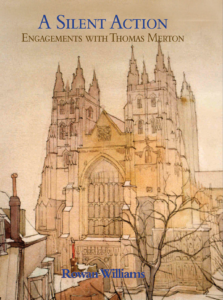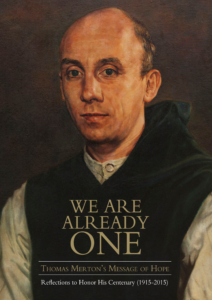A SILENT ACTION
Review by Christopher Pramuk
Published in The Living Church (July 15, 2012): 21-24.
One of the brightest threads in the ever-expanding and sometimes less than inspiring tapestry of “Merton Studies” is the Anglican-Eastern Orthodox trajectory. The late Canon A.M. “Donald” Allchin, a friend and correspondent of Merton’s, may be credited as the “father” of this line of scholarship, which traces the considerable effect of Eastern Orthodox mysticism and theology on Merton’s thought and, in so doing, illuminates his extraordinary ecumenical sensibilities.
It was Allchin’s shimmering essays in the landmark volume Merton and Hesychasm: Prayer of the Heart and the Eastern Church (Fons Vitae, 2003) which first awakened me, with a wonderful jolt, to Merton’s turn to the Christian East during the late 1950s, and above all his immersion in the “sophianic” tradition of Russian Orthodoxy, much less known than his forays into Zen and other non-Christian Eastern traditions. One also finds in that volume a seminal early study on Merton and Russian Orthodoxy first published in 1975 by one of Allchin’s students at Oxford, then a promising young scholar named Rowan Williams.
Williams has, by his own account, not been able to let him go. Four more essays would follow, most recently a tribute to Merton and Karl Barth on the shared 40th anniversary of their deaths (Dec. 10, 1968). Silent Action is a small gem of a book, gathering five essays and a poem that represent a very rich vein of ecumenical conversation in the latter half of the 20th century, and some of the best commentary on Merton anywhere to be found. That is because Williams, like Merton, is a poet, priest, and theologian who embodies with uncommon sensitivity and grace what these vocations, too often oppositional in practice, intrinsically share: a commitment to the sacramentality of language.
Indeed as much as Merton advocates Christian and societal renewal through the “silent action” of the contemplative life, he could not escape, any more than the Christian can escape today, the profound need for the renewal of language in the public square. As Williams has it, Merton had no option but to “break silence,” that is, “to act so as to make something different happen in words” (p. 65), not least by “smelling out death” in the present corruption of language (p. 50). The poetic and prophetic task is to interrogate the repetition of “old words for God, safe words for God, lazy words for God, useful words for God” (p. 50). The poet and prophet remind us that we “live under a very broad sky — which is sometimes a night sky” (p. 51). So also, properly, with the theologian.
In these essays Williams gets the dilemma of language, present everywhere in Merton’s thought, exactly right. On the one hand, we need theology and Christian doctrine “because we need some notion of what it is we are trying to be attuned to” (p. 50); on the other hand, where doctrine makes no room for renewal, for the prayerful grasp of the Spirit’s continuing action in history, “then doctrine is a waste of time; it becomes purely and simply old, safe, and useful” (p. 50). As a poet and contemplative Merton models the “costly openness” demanded by Christian love, an incarnate love in which we ourselves seek to become “new words for God” (p. 49). The alternative temptation, what Archbishop Williams calls “the politics of the self-enclosed world” (p. 65), makes us into prisoners of our own “controlling will” (p. 51) and our public spaces into fields of warfare.
I have long felt, without quite understanding why, that books with large, stock photographs of Merton on their covers are best avoided. Happily this book avoids that impulse, but more importantly, Williams reminds us why hagiographical treatments of Merton are so often misplaced: “The great Christian is the man or woman who can make me more interested in God than in him or her” (p. 19). Merton is a great Christian because he “will not let me look at him for long: he will, finally, persuade me to look in the direction he is looking,” toward a world everywhere haunted by God. Thus Merton’s genius as a writer is akin to the “poverty of the priest who vanishes into the Mass” (p. 19); he does not “organize, dominate, or even interpret” so much as show how to respond attentively — here, now, to every environment in which we find ourselves.
What sets this book apart is Williams’s commitment to commend Merton himself gratefully to God, as it were, in order to help us “turn further in the direction [Merton] is looking, in prayer, poetry, theology, and encounter with the experience of other faiths” (p. 19). With lucid economy of prose and often breathtaking insight, Williams shows us that Merton’s greatest gift may not be what he wrote so much as the way that he wrote, a way of Christian engagement both within and far beyond the Church that opens “a space for the conversation of free people” (p. 67). Whether Christianity is equipped for civic life today will depend not a little on whether Christians themselves make room in daily practice for the costly “grace of experiencing a true present, a sophianic depth in things” (p. 67). This book enriches us with two seasoned and very trustworthy guides for the journey.
Christopher Pramuk is associate professor of theology at Xavier University in Cincinnati and the author of Sophia: The Hidden Christ of Thomas Merton.
Review of ‘We Are Already One’ in the Presence Journal
We Are Already One: Thomas Merton’s Message of Hope: Reflections to Honor His Centenary (1915–2015)
edited by Gray Henry and Jonathan Montaldo
Louisville, KY: Fons Vitae, 2014
384 pages, CAD$31.95, GBP£23.99, USD$26.95 Reviewed by Ellie Stratton
A compilation of one hundred essays, We Are Already One:
Thomas Merton’s Message of Hope: Reflections to Honor His Centenary (1915–2015)
celebrates the man whose life and writings have influenced women and
men across faith traditions and around the globe since his autobiography The
Seven Storey Mountain was first published in 1948. This book overflows
with heartfelt contributions from a diverse group of artists, biographers,
monks, musicians, poets, teachers, and theologians, most of whom met
Merton after his death through his books and journals. They share a love
affair with Merton’s searching spirit and reminisce about when they were first
introduced to him and how he changed their lives.
The “many faces of Thomas Merton” (41) are portrayed through stories and quotes about Merton the contemplative monk of Gethsemani Abbey, but also about Merton the poet, the prophet, the priest, the artist, the correspondent, the photographer, and the friend. Those who knew Merton as a spiritual director lift up the qualities of humility, availability, and common sense—and especially the spiritual director as a guide who knows by experience the transformative process of learning from God how to find one’s way in the intimate matters of the heart’s awakening to the cosmic dance (157). The enduring truth of Merton’s life is that a person can search, evolve, transform, and deepen, and can find one’s true self in the precise circumstances in which one finds himself or herself. This is the profound message of hope illustrated throughout this compelling volume.
Merton said of himself, “I stand among you as one who offers a small message of hope.” His hope was grounded in a place of love beyond words, where his deepest self and God’s Spirit were One Spirit. The book poignantly expresses a man who shares his struggles and breakthroughs, who said at one time “my vocation is prayer,” whose ever-increasing inclusivity and steady evolution out of parochial religion into universal inter- spirituality are daring examples to each reader. The invitation is to set a course for the truth behind the veils of label, mask, and role, and to embrace the contemplative path with renewed enthusiasm. The contemplative path did not take Merton away from the world. It increased his connection with people of every culture and creed, a conviction expressed among his final words, “My dear brothers and sisters, we are already one. But we imagine that we are not. So what we have to recover is our original unity. What we have to be is what we are.”
We Are Already One is best savored by reading it in a contemplative lectio divina manner to let the insights and cadences of Merton’s life and words sink in. It is inspirational for everyone
already acquainted with the twentieth-century mystic and replete with biographical information. For individuals newly encountering Merton, this book will get you well on your way to saying what so many others have said: “Merton changed my life.” ■
Ellie Stratton, MDiv, lives in Pennsylvania, USA, and offers spiritual direction at the Wayne Presbyterian Church. She serves on the faculty of the Kairos School of Spiritual Formation in Lancaster, Pennsylvania. Her e-mail address is estratton54@gmail.com.


